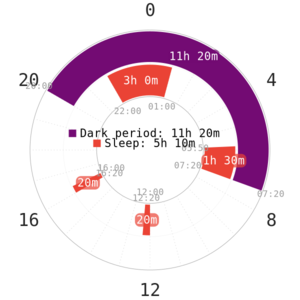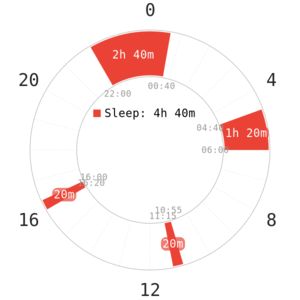DC2
Mechanism
Dual Core 2, or DC2, is the second dual core schedule, a logical upgrade from DC1 with the addition of 1 nap and some sleep reduction from the core sleeps. The total sleep of DC2 hovers around the hospitable zone for long-term sustenance, approximately ~5-5.5h of total sleep each day. With 2 core sleeps placed around the sleep peaks and 2 supplemental naps in the day, DC2 is similar to E3-extended in sleep distribution and offers a decent napping frequency to learn the napping behavior. DC2 in a way resembles E3, except that the first nap of E3 is now the second core in DC2.
The first core sleep is typically longer than the second core sleep to obtain an ideally sufficient amount of SWS, while the second core has a lot of room for REM sleep. With a 3h core (2 full cycles) in SWS peak hours, SWS is likely preserved after repartitioning is completed, and SWS deprivation symptoms on DC2 are overall a lot milder than schedules with only 1-cycle core sleeps around SWS peak/night hours. The naps provide more alertness boost to sustain the long wake gap in the day as the core duration becomes shorter, and meet the remaining REM sleep requirements. The second nap on DC2 may not give any REM sleep, and just NREM2 or trace SWS instead if it is placed in mid/late afternoon (e.g, after ~4 PM). Because of the reduced total core duration compared to that of DC1, an extra nap has to be added to compensate for the reduced amount of REM sleep in the second core of DC2.
In addition, DC2 is also a middle ground between the easier DC1 and the advanced DC3. The total sleep is not as high as DC1-extended and not as low as DC3, which is a favorable zone of total sleep for flexing sleep after adaptation. The total sleep is equivalent to E2, but the splitting of core sleeps will provide a deeper core experience for the first core, and high likelihood for vivid/lucid dreaming in the second core as SWS is met in the first core. The wake gap between 2 cores is also large enough for certain favorite nighttime activities, including certain brainstorming or somewhat mentally taxing duties without having to worry about cooling down for the second core around sunrise hours too soon. 4 sleeps per day also renders the wake gap between each sleep more manageable than on E2 for instance. Skipping one nap as a result may be tolerable during adaptation, as long as this does not happen too often.
Adaptation
It is generally considered that adapting to multi-core schedules (more than 1 core sleep) is harder than to schedules with only 1 core sleep (e.g, Everyman), except in the case of naturally segmented sleepers who are used to sleeping in more than one core sleep. This is believed to be the case because repartitioning of vital sleep stages into both core sleeps becomes more complicated, and this doubles the chance for SWS wakes from both cores during adaptation. Thus, adaptation to DC2 in general is at least as difficult as that to E2, or possibly as challenging as to E3 (3.5h core) for non-natural Segmented sleepers. Initially, splitting the monophasic core sleep into 2 smaller cores can result in a much rougher wake from the first core, if the cold turkey adaptation method is chosen.
Alternatively, a gradual adaptation method from DC1 is also viable, but it also has more limited success than the cold turkey method. It is also worth noting that after the adaptation to DC2 is completed, one can proceed to flexing the naps and the core(s) and adapt to DUCAMAYL, or transition to DC3. The first core sleep on DC2 can naturally shorten by 30m (becoming 2.5h core instead) as a result of compressed repartitioning and high frequency of sleep, but this is not guaranteed for everyone.
Alternate Variants
Over the years, there have been a lot of changes in DC2 scheduling. A lot of principles and bases discovered throughout these years have opened up multiple possibilities for a DC2 setup, making DC2 a very underrated schedule.
Slightly modified core duration
This scheduling variant was proposed by Polyphasic Society a long time ago, which gives an extra amount of sleep reduction compared to the standard variant. Totaling 4h40m of sleep, this version may be more appealing to adapt to than the standard version, as it also gives a similar amount of total sleep to E3 (3.5h core and 3 20m naps). The basis of this version was to induce a bit more sleep reduction in the first core sleep and add a second nap. However, it is not recommended to schedule a 2.5h core from the beginning, because it likely will result in heavy SWS wakes and increases the chance for oversleeping. As mentioned above, there is still some chance for the automatic reduction in the SWS core's length after adaptation, so it is not necessary to adapt to this variant. This total sleep may also contribute to the potential inflexibility of the schedule after adaptation, or make it a lot more difficult to flex each sleep block. Throughout the years, there were virtually no successful adaptations to this DC2 variant. It may benefit sleepers with lower SWS requirements or shorter overall sleep duration on monophasic sleep, though.
Similar to the Polyphasic Society's proposal of a possible DC2 variant, this DC2 variant stresses on the final goal once the adaptation is completed - to compress both core sleeps down to a multiple of 80m cycles (from 90m). The common approach would be to adapt to the original 3-1.5 standard combination, and then wait for the compression to occur, thanks to the frequency of sleep. It is not recommended to start an adaptation with this variant, however, because of the increased chance to run into SWS/REM wakes that give an excessive amount of sleep inertia that could be alleviated in the standard setup.
Early rotation/Pronap
This interesting DC2 variant rotates the whole schedule backward, to earlier hours. The premise behind this distribution of sleeps is to place most sleep blocks to night hours, and only have one nap in the day. As a result, the wake gap between each core is possibly smaller than on the standard version. The first nap is placed at the usual position of the second core, and as a result, it is very similar to an Everyman schedule. The first core likely will contain most SWS needs, while the second core may be a mixed core (containing both SWS and REM, but likely more REM sleep). Both naps may contain REM sleep, which can boost the chance to recall dreams.
Alternatively, the first nap can be extended to become a Pronap (e.g, 30m) to better sustain wakefulness and provide more REM sleep for individuals with somewhat higher REM requirements, because the first nap is located in REM peak. The reason a Pronap can be used is that both core sleeps mostly cover all SWS needs, leaving basically no room for SWS to occur in this hypothetical Pronap. The Pronap can then yield better wakefulness sustaining, and can become flexible after adaptation. However, it is important to note that this is a new proposal for an alternate DC2 variation, and has not been tested. There is also little incentive to try out this early rotation/Pronap variants, because the first core is too early in the evening, and becomes socially liable for a lot of people.



